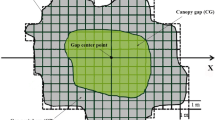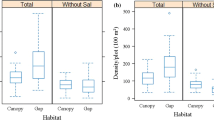Abstract
The study was carried out in ten natural canopy gaps in the SantaGenebra County Reserve (22°49′45″S, 47°06′33″W)in the county of Campinas, São Paulo State, Brazil. The size and canopyopenness of the gaps were studied using hemispherical photographs. Thevegetation survey included all shrubs and trees with height ≥ 0.50m in the gaps interiors and all the individuals with PBH(perimeterat breast height) ≥ 15 cm in a 3 m surroundingborder of the gaps. The similarity among the gaps and among their surroundingareas was assessed by the Jaccard similarity index and by cluster analyzes. Thegap size varied from 20.09 to 468 m2, with apredominance of small gaps. The families with the greatest species richness inthe gaps were Rutaceae, Rubiaceae and Euphorbiaceae. The species with thegreatest number of individuals in the gaps were Coffeaarabica L., Hybanthus atropurpureus (St. Hil.)Taub. and Actinostemon klotschii (Muell. Arg.) Pax, allwidely distributed in the understorey. Shade-tolerant species (late secondaryspecies) predominated in function of the predominance of small gaps. The highnumber of species found in the gaps reflects the importance of thesedisturbances in the maintenance of species diversity in the studied forest.
Similar content being viewed by others
References
Abe S., Masaki T. and Nakashizuka T. 1995. Factors influencing sapling composition in canopy gaps of a temperate deciduous forest. Vegetatio 120: 21–32.
Amézquita P. 1998. Light environment affects seedling perform-ance in Psychotria aubletiana (Rubiaceae), a tropical understory shrub. Biotropica 30: 126–129.
Ashton P.S. 1989. Species richness in tropical forests. In: Holm-Nielsen L.B., Nielsen I.C. and Balsav H. (eds), Tropical Forest: Botanical Dynamics, Speciation and Diversity. Academic Press, New York, pp. 101–110.
Barton A., Fetcher N. and Redhead S. 1989. The relationship between treefall gap size and light flux in a Neotropical rain forest in Costa Rica. Journal of Tropical Ecology 5: 437–439.
Bernacci L.C. and Leitão Filho H.F. 1996. Flora fanerogâmica da floresta da Fazenda São Vicente, Campinas, SP. Revista Brasileira de Botânica 19: 149–164.
Brokaw N.V.L. 1982a. Treefalls: frequency, timing, and consequences. In: Leight E.G., Rand A.S. and Windsor D.M. (eds), The Ecology of a Tropical Forest: Seasonal Rhythms and Long-Term Changes. Smith. Inst. Press, Washington, pp. 101–108.
Brokaw N.V.L. 1982b. The definition of treefall gaps and its effect on measures of forest dynamics. Biotropica 14: 158–160.
Brokaw N.V.L. 1985. Treefalls, regrowth, and community structure in tropical forests. In: Pickett S.T.A. and White P.S. (eds), The Ecology of Natural Disturbance and Patch Dynamics. Academic Press, New York, pp. 53–69.
Brokaw N.V.L. 1987. Gap-phase regeneration of three pioneer tree species in a tropical forest. Journal of Ecology 75: 9–19.
Brown N. 1993. The implications of climate and gap microclimate for seedling growth conditions in a Bornean lowland rain forest. Journal of Tropical Ecology 9: 153–168.
Chandrashekara U.M. and Ramakrishnan P.S. 1993. Gap-phase regeneration of tree species of differing successional status in a humid tropical forest of Kerala, India. Journal of Bioscience 18: 279–290.
Chazdon R.L. and Field C.B. 1987. Photographic estimation of photosynthetically active radiation: evaluation of a computerized technique. Oecologia 73: 525–532.
Cintra R. and Horna V. 1997. Seed and seedling survival of the palm Astrocaryum murumuru and the legume tree Dipteryx micrantha in gaps in Amazonian forest. Journal of Tropical Ecology 13: 257–277.
Costa M.P. and Mantovani W. 1992. Composição florística e estrutura de clareiras em mata mesófila na Bacia de São Paulo. Revista do Instituto Florestal 2: 178–183.
Cronquist A. 1988. The Evolution and Classification of Flowering Plants. The New York Botanical Garden, New York.
Denslow J.S. 1980. Gap partioning among tropical rainforest trees. Biotropica 12: 47–55.
Denslow J.S. 1987. Tropical rain forest gaps and tree species diversity. Annual Review of Ecology Systematics 18: 431–451.
Denslow J.S. and Gomez A.E. 1990. Seed rain to treefall gaps in a neotropical rain forest. Canadian Journal of Forest Research 20: 640–648.
Eastman J.R. 1995. IDRISI for Windows. Clark University Graduate School of Geography, St. Worcester.
Gandolfi S. 1991. Estudo florístico e fitossociológico de uma floresta residual na área do Aeroporto Internacional de São Paulo, Município de Guarulhos, SP. MS.
Gandolfi S., Leitão Filho H.F. and Bezerra C.L.F. 1995. Levantamento florístico e caráter sucessional das espécies arbustivoarbóreas de uma floresta semidecídua no município de Guarulhos, SP. Revista Brasileira de Biologia 55: 753–767.
Gauch H.G. 1982. Multivariate analysis in community ecology. Cambridge University Press, Cambridge.
Gentry A.H. and Emmons L.H. 1987. Geographical variation in fertility, phenology, and composition of neotropical forests. Biotropica 19: 216–225.
Green P.T. 1996. Canopy gaps in rain forest on Christmas Island, Indian Ocean: size distribution and methods of measurement. Journal of Tropical Ecology 12: 427–434.
Hartshorn G.S. 1980. Neotropical forests dynamics. Biotropica 12: 23–30.
Kneeshaw D.D. and Bergeron Y. 1998. Canopy gap characteristics and tree replacement in the southeastern Boreal forest. Ecology 79: 783–794.
Knobel M.G. 1995. Aspectos da regeneração natural do componente arbóreoarbustivo, de trecho da floresta da Reserva Biológica do Institute de Botânica em São Paulo, SP. MS.
Leitão Filho H.F. 1995. A vegetação: a vegetação da Reserva de Santa Genebra. In: Morellato L.P.C. and Leitão Filho H.F. (eds), Ecologia e preservação de umafloresta tropical urbana: Reserva de Santa Genebra. Editora da UNICAMP, Campinas, pp. 19–29.
Martinez-Ramos M. and Soto-Castro A. 1993. Seed rain and advanced regeneration in a tropical rain forest. Vegetatio 108: 299–318.
Martins S.V. and Rodrigues R.R. 1999. Produção de serapilheira em clareiras de uma floresta estacional semidecidual no município de Campinas, SP. Revista Brasileira de Botânica 22: 405–412.
Masaki S.A.T. and Nakashizuka T. 1995. Factors influencing sapling composition in canopy gaps of a temperate deciduous forest. Vegetatio 120: 21–32.
McCune B. and Mefford M.J. 1997. PC-ORD for Windows: Multivariate Analysis of Ecological Data - Version 3.12. MJM Software Design, Gleneden Beach, Oregon.
Mueller-Dombois D. and Ellenberg H. 1974. Aims and Methods of Vegetation Ecology. John Wiley & Sons, New York, 574 p.
Negrelle R.R.B. 1995. Sprouting after uprooting of canopy trees in the Atlantic rain forest of Brazil. Biotropica 27: 448–454.
Okuda T., Kachi N., Yap S.K. and Manokaran N. 1997. Tree distribution pattern and fate of juveniles in a lowland tropical rain forest-implications for regeneration and maintenance of species diversity. Plant Ecology 131: 155–171.
Oliveira J.B., Menk J.R.F. and Rotta C.L. 1979. Levantamento semidetalhado dos solos do Estado de São Paulo. Quadrícula de Campinas, IBGE, Rio de Janeiro. (Série Recursos Naturais e Meio Ambiente, 5).
Orians G.H. 1982. The influence of tree falls in tropical forest on tree species richness. Tropical Ecology 23: 255–279.
Pascarella J.B. 1998. Resiliency and response to hurricane disturbance in a tropical shrub, Ardisia escallonioides (Myrsinaceae), in south Florida. American Journal of Botany 85: 1207–1215.
Pickett S.T.A. 1983. Differential adaptation of tropical species to canopy gaps and its role in community dynamics. Tropical Ecology 24: 68–84.
Reader R., Bonser S.P., Duralia T.E. and Briecker B.D. 1995. In-terspecific variation in tree seedling establishment in canopy gaps in relation to tree density. Journal of Vegetation Science 6: 609–614.
Rich P.M., Clark D.B., Clark D.A. and Oberbauer S.F. 1993. Long-term study of solar radiation regimes in a tropical wet forest using quantum sensors and hemispherical photography. Agricultural and Forest Meteorology 65: 107–127.
Rodrigues R.R. 1992. Análise de um remanescente de vegetaçáo natural às margens do Rio Passa Cinco, IpeÚna, SP. DS.
Rollet B. 1983. La régenération naturalle dans les trouées: un processus général de la dynamique des forêts tropicales humides (1). Revue Bois et Forêts des Tropiques 201: 19–33.
Runkle J.R. 1981. Gap regeneration in some old-growth forest of eastern United States. Ecology 62: 1041–1051.
Santos F.A.M., Rodrigues R.R., Tamashiro J.Y. and Shepherd G.J. 1996. The dynamics of tree populations in a semideciduous forest at Santa Genebra reserve, Campinas, SE, Brazil. Supplement to bulletin of the Ecological Society of America 77: 389–341.
Setzer J. 1966. Atlas climático e ecológico do Estado de São Paulo. Comissão Interestadual da Bacia do Paraná-Uruguai e Centrais Elétricas do Estado de São Paulo, São Paulo.
Shepherd G.J. 1996. Fitopac 1 - Manual do usuario. Universidade Estadual de Campinas, Campinas.
Steege H. 1993. HEMIPHOT - a program to analyze vegetation indices, light and light quality from hemispherical photographs. The Tropenbos Foundation, Wageningen.
Swaine M.D. and Hall J.B. 1983. Early succession on cleared forest land in Ghana. Journal of Ecology 71: 601–627.
Tabarelli M. 1994. Clareiras naturais e a dinâmica sucessional de um trecho de floresta da Serra da Cantareira, SP. MS.
Tabarelli M. 1997. A regeneração dafloresta atlântica montana. DS.
Tabarelli M. and Mantovani W. 1997a. Colonização de clareiras naturais na floresta atlântica no sudeste do Brasil. Revista Brasileira de Botânica 20: 57–66.
Tabarelli M. and Mantovani W. 1997b. Ocupação de clareiras naturais na floresta na Serra da Cantareira - SP. Naturalia 22: 89–102.
Toniato M.T.Z., Leitão Filho H.F. and Rodrigues R.R. 1998. Fitossociologia de um remanescente de floresta higrófila (mata de brejo) em Campinas, SP. Revista Brasileira de Botânica 21: 197–210.
Trichon V., Walter J.M.N. and Laumonier Y. 1998. Identifying spatial patterns in the tropical rain forest structure using hemi-spherical photographs. Plant Ecology 137: 227–244.
Uhl C., Clark K., Dezzeo N. and Maquirino P. 1988. Vegetation dynamics in Amazonian treefall gaps. Ecology 69: 751–763.
Valverde T. and Silvertown J. 1997. Canopy closure rate and forest structure. Ecology 78: 1555–1562.
Van der Meer P.J. and Bongers F. 1996. Formation and closure of canopy gaps in the rain forest at Nouragues, French Guiana. Vegetatio 126: 167–179.
Vandermeer J., Boucher D., Perfecto I. and de la Cerda I.G. 1996. A theory of disturbance and species diversity: evidence from Nicaragua after hurricane Joan. Biotropica 28: 600–613.
Walter N.J. and Torquebiau E.F. 1997. The geometry of the canopy of dipterocarp rain forest in Sumatra. Agricultural and Forest Meteorology 85: 99–115.
Webb E.L. 1998. Gap-phase regeneration in selectively logged lowland swamp forest, northeastern Costa Rica. Journal of Tropical Ecology 14: 247–260.
Whitmore T.C. 1982. On pattern and process in forests. In: New-man E.I. (ed.), The Plant Community as a Working Mechanism. Blackwell Scientific, Oxford, pp. 45–58.
Whitmore T.C., Brown N.D., Swaine M.D., Kennedy D., Goodwin-Bailey C.I. and Gong W.K. 1993. Use of hemispherical photo-graphs in forest ecology: measurement of gap size and radiation totals in a Bornean tropical rain forest. Journal of Tropical Ecology 9: 131–151.
Wilkinson L. 1991. SYSTAT: The System for Statistics. SYSTAT Inc., Evanston.
Yavitt J.B., Battles J.J., Lang G.E. and Knight D.H. 1995. The canopy gap regime in a secondary neotropical forest in Panama. Journal of Tropical Ecology 11: 391–402.
Author information
Authors and Affiliations
Rights and permissions
About this article
Cite this article
Venâncio Martins, S., Ribeiro Rodrigues, R. Gap-phase regeneration in a semideciduous mesophytic forest, south–eastern Brazil. Plant Ecology 163, 51–62 (2002). https://doi.org/10.1023/A:1020395519430
Issue Date:
DOI: https://doi.org/10.1023/A:1020395519430




